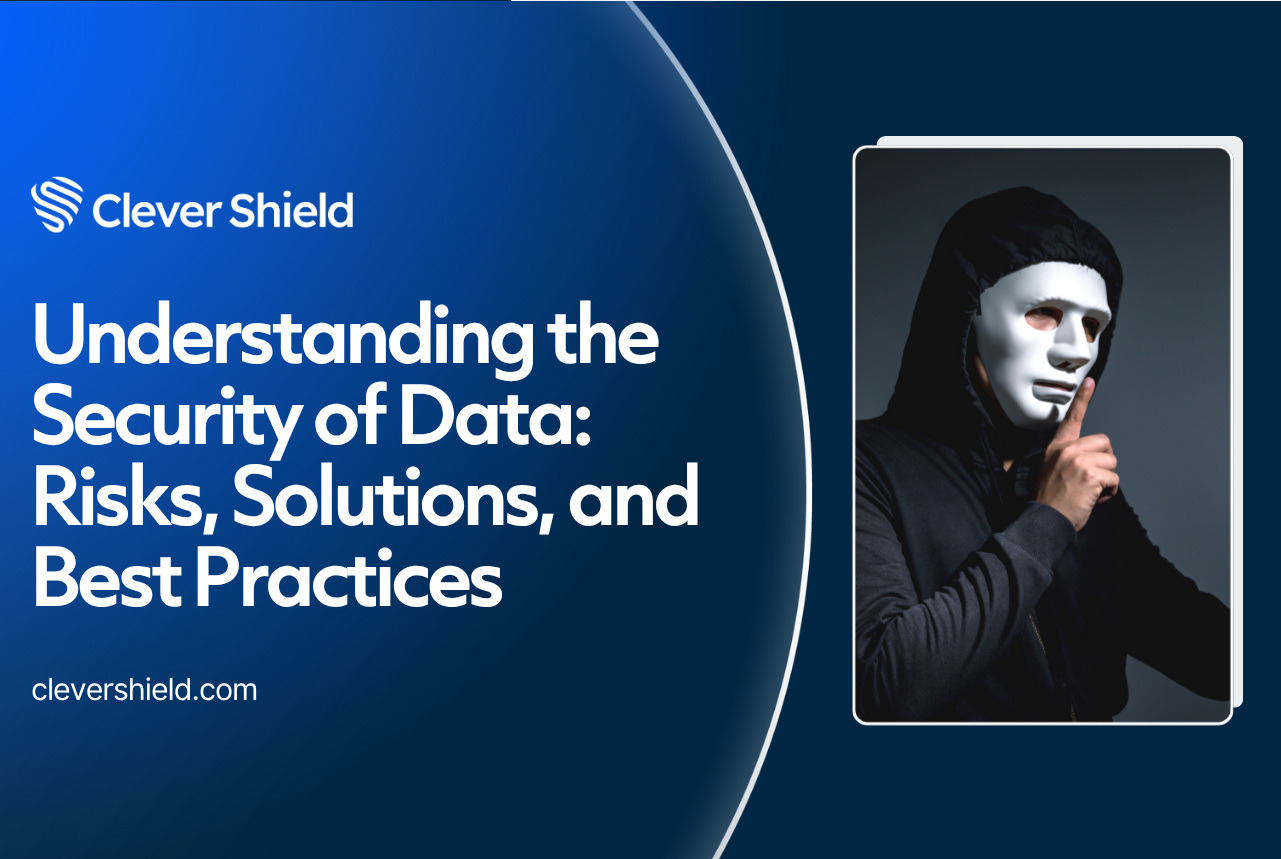How can you keep your sensitive information safe from unauthorized access and breaches? This article breaks down what you need to know about the security of data: common threats, best practices, and effective strategies.
Key Takeaways
Data security is essential for safeguarding digital information from unauthorized access and corruption, involving strategic planning, advanced technology, and strong organizational practices.
Organizations must comply with data protection regulations like GDPR and HIPAA, as failure to do so can lead to severe reputational and financial damage.
Implementing layered defense strategies, such as encryption, access controls, and data loss prevention (DLP), is critical for protecting sensitive information and mitigating security threats.
What is Data Security?
Data security entails safeguarding digital information from unauthorized access, corruption, or theft throughout its entire lifecycle. It is a critical aspect of maintaining the confidentiality, integrity, and availability of data, which are the cornerstone principles of data security. A combination of strategic planning, advanced technology, and a strong organizational culture is necessary for effective data security. These measures ensure data secure remains a valuable organizational asset by protecting it from unauthorized access and corruption. Additionally, understanding why data security important is essential for organizations today, especially when considering data security vs other priorities.
Data security employs mechanisms such as:
Encryption, which converts readable data into an unreadable format
Access controls that limit access to sensitive information
Data masking, which protects data by obscuring sensitive information
Data erasure, which permanently destroys sensitive information
The goal is to prevent unauthorized users from accessing or manipulating secure data to steal data, thus maintaining its integrity and confidentiality.
Governance, Risk Management, and Compliance (GRC) play a significant role in ensuring adherence to best practices and compliance mandates, further enhancing data security. Implementing effective data security measures helps organizations protect sensitive data from unauthorized access, data breaches, and other incidents that could compromise data integrity and cause significant financial and reputational damage.
Importance of Data Security
Organizations have a legal obligation to protect customer data from theft or loss, as failing to do so can result in severe repercussions. Major data protection regulations include data security regulations:
General Data Protection Regulation (GDPR)
California Consumer Privacy Act (CCPA)
Health Insurance Portability and Accountability Act (HIPAA)
Payment Card Industry Data Security Standard (PCI DSS)
These regulations impose strict guidelines on how data should be handled. Compliance with these regulations is not just a legal requirement but also a crucial step in safeguarding an organization’s data and maintaining customer trust.
A data breach can be catastrophic, severely damaging an organization’s reputation, causing significant loss of customer trust, and potentially leading to business decline. Regular security audits help organizations identify vulnerabilities and implement protective measures, safeguarding their reputation and ensuring customer data security.
Investing in data security measures can also reduce future costs associated with fixing security flaws and mitigating attacks. Effective data security offers a competitive advantage by better protecting sensitive information, thereby instilling confidence in customers and stakeholders. With data breaches becoming increasingly common, robust data security is imperative for an organization’s survival and success.
Common Data Security Threats
Cyberattacks, employee negligence, and malicious insiders are among the myriad data security threats organizations face that can compromise sensitive information. Malware, which includes various types of malicious software, is designed to compromise systems and steal or damage data. Ransomware, a specific type of malware, holds data hostage, requiring payment to regain access, posing a significant threat to organizations.
Phishing attacks are another prevalent threat where attackers manipulate users into providing sensitive information through deceptive communications. These attacks often involve sending messages that appear to come from trusted sources to lure individuals into revealing personal or financial information.
Insider threats, which involve current or former employees misusing their access for malicious purposes, are also a significant concern. These threats underscore the importance of implementing robust data security measures to protect sensitive data from unauthorized access and data breaches.
Employee negligence and human error also play a significant role in data security risks. Simple mistakes, such as misconfiguring security settings or falling for phishing scams, can lead to significant data breaches and data corruption. Organizations must address these vulnerabilities by providing regular training and awareness programs, ensuring employees understand the importance of data security and can recognize and respond to potential threats.
Key Elements of a Robust Data Security Strategy
A robust data security strategy is essential for defending against various cyber threats while facilitating secure and efficient data utilization. Multiple layers of defense are involved in effective data security, such as:
Encryption
Access controls
Authentication protocols
These measures work together to protect sensitive data from unauthorized access, data breaches, and other security incidents, including transport layer security.
Common types of data security are:
Encryption
Data masking
Data erasure
Data resiliency
Each of these techniques plays a crucial role in protecting data at different stages of its lifecycle.
Methods for securing data and systems include:
Encryption, which secures data during transmission and storage
Access controls, which limit data access based on user roles
Data masking, which obscures sensitive information to prevent unauthorized access
Security controls, which are crucial for securing systems against vulnerabilities.
Regular software updates, which are crucial for securing systems against vulnerabilities.
Encryption Techniques
Encryption converts readable data into an unreadable format, ensuring only authorized users with the decryption key can access the original data. This technique is essential for data encryption, encrypting data, and securing sensitive data during transmission and storage, providing robust protection against data breaches. Additionally, it encrypts data to enhance security and allows organizations to encrypt data effectively.
There are various encryption techniques used to protect data, including symmetric and asymmetric encryption. Symmetric encryption uses the same key for both encryption and decryption, making it faster but requiring secure key management. Asymmetric encryption, on the other hand, uses a pair of keys—one for encryption and one for decryption—providing enhanced security but at the cost of increased computational overhead. These encryption methods ensure that sensitive information remains secure both during transmission and at rest.
Organizations typically use security tools for key management and decryption controls to implement encryption effectively. These tools ensure encryption keys are stored securely and rotated regularly to prevent unauthorized access. Robust encryption techniques significantly enhance data security and protect sensitive information from potential threats.
Access Control Mechanisms
Access control mechanisms ensure only authorized users can access sensitive information, forming a critical component of a robust data security strategy. Key aspects include:
The principle of least privilege, which entails granting users access only to the information necessary to perform their job functions and grant access only to what is essential.
Minimizing potential data exposure by limiting access.
Reducing the risk of unauthorized access and data breaches by restricting the amount of sensitive data users can access and control access, allowing them to gain access only to what they need.
Identity Access Management (IAM) is a comprehensive framework that streamlines user access management by assigning specific permissions based on roles. IAM facilitates a focused and secure access approach, ensuring that users only have access to the resources they need. This system also includes strict access management protocols and monitoring of user activity to safeguard proprietary information and detect any unauthorized access attempts, while also aiming to manage user identities effectively.
Regular permission reviews are crucial for maintaining effective access controls and reducing the risk of privilege creep, where users accumulate more access rights than necessary over time. By regularly auditing user permissions and making adjustments as needed, organizations can ensure that access controls remain effective and that sensitive data is protected from unauthorized access.
Data Masking Methods
Data masking obscures and replaces specific data to protect sensitive information. It replaces sensitive data with fictitious but similar data to prevent unauthorized access while maintaining the format for analysis. This technique is especially useful in non-production environments like testing and development, where real data isn’t required.
Data masking techniques include:
Encryption: encodes readable data.
Character shuffling: rearranges data characters.
Data substitution: replaces sensitive data with fictitious data of the same format.
These methods protect sensitive information from unauthorized access while remaining useful to access sensitive data and expose sensitive data for analysis and testing.
Effective data masking ensures the masked data cannot be reverse-engineered to reveal the original sensitive information. This requires using strong masking techniques and regularly updating the masked data to prevent vulnerabilities. By employing effective data masking methods, organizations can protect sensitive information and maintain data security in various environments.
Data Loss Prevention (DLP)
Data Loss Prevention (DLP) encompasses strategies to protect sensitive data from unauthorized access and loss, designed to monitor, detect, and prevent potential data breaches. An effective data protection strategy includes measures such as regular audits, classifying sensitive data, and utilizing secure backup solutions to ensure data integrity and availability.
Forms of DLP solutions include:
Network DLP, which monitors data in transit
Endpoint DLP, which focuses on data stored on user devices and mobile devices
Cloud DLP, which protects data in cloud environments
These solutions help organizations monitor data flow, detect potential threats, and prevent unauthorized access to sensitive information.
DLP solutions reduce financial risks associated with data breaches and protect sensitive customer information through effective monitoring and alerting mechanisms. Implementing DLP solutions enhances an organization’s data security posture, ensures compliance with data protection regulations, and protects sensitive data from potential threats.
Cloud Data Security
Cloud data security involves technologies, policies, services, and controls to safeguard sensitive data and applications within a cloud environment. It is critical for ensuring privacy and protection of data across cloud environments, mitigating risks associated with unauthorized access. The shared responsibility model in cloud environments divides security responsibilities between the cloud provider and the customer.
Multi-tenancy, which allows various organizations to share resources in the cloud, presents substantial security challenges compared to private cloud setups. Organizations face difficulties controlling data loss in cloud settings, presenting risks of unauthorized sharing and access from unsecured networks. To enhance security in multi-tenant environments, organizations should implement strong access controls, encryption, and regular audits.
Unauthorized access in multi-tenant environments often results from weak passwords and system vulnerabilities, emphasizing the need for robust access management. Regular automated configuration scans are essential to identify security oversights and maintain robust cloud security, as highlighted by the Capital One breach. Implementing these measures helps organizations protect sensitive data in cloud environments and ensure compliance with data protection regulations.
Insider Threats and How to Mitigate Them
Individuals with authorized access can pose insider threats by intentionally or unintentionally compromising organizational data. A mature insider threat program involves defining, detecting, assessing, and proactively managing threats to prevent incidents. Mitigating insider threats effectively requires a combination of physical security measures and personnel awareness strategies.
Recognizing concerning behaviors among employees is crucial for the early detection of potential insider threats. Key measures to prevent insider threats include:
Conducting regular cybersecurity training for employees to enhance overall awareness of security issues.
Restricting sensitive data access to essential personnel only.
Implementing real-time monitoring of insider activities.
The Tesla 2023 insider data leak underscores the importance of these measures.
Implementing these strategies helps organizations mitigate insider threats and protect sensitive data from unauthorized access. Regular training, monitoring, and access controls are essential components of an effective insider threat program.
Role of Regular Security Audits
Regular security audits are essential for identifying assets that require protection and mapping potential risks. These audits help organizations ensure compliance with relevant regulations, reducing the likelihood of penalties. Regular security assessments promote a culture of transparency and instill good cybersecurity practices among employees.
Security audits help companies allocate resources and budget effectively for security improvements. For example, Pegasus Airlines’ data leak incident revealed the critical need for comprehensive cybersecurity training and regular security audits to prevent misconfigurations. Conducting these audits at least every few months helps maintain effective security measures and address issues promptly.
Organizations can use third-party experts or in-house security teams to conduct security audits, depending on their resources and requirements. When audits expose issues, dedicating time and resources to address and remediate them is crucial. Regularly auditing security measures strengthens an organization’s data security posture and protects sensitive information from potential threats.
Best Practices for Data Security
Implementing best practices for data security is essential for protecting sensitive information and preventing data breaches. Key practices include:
User training on data handling best practices to mitigate risks of data leakage, especially in shared cloud environments.
Training employees on phishing awareness.
Maintaining multi-factor authentication to close security gaps and enhance overall data security.
Establishing a clear incident response plan helps organizations respond swiftly to security breaches and minimize potential damage. Practices for enhancing data security include:
Using unique and strong passwords to protect sensitive information.
Selecting, managing, and maintaining secure passwords.
Enforcing longer passwords and frequent changes as a best practice for managing passwords.
Regular audits help organizations detect outdated security policies and highlight the need for employee training. Implementing these best practices helps organizations protect sensitive data, ensure compliance with data protection regulations, and maintain a strong security posture.
Clever Shield: Active Data Protection Solution
Clever Shield is an advanced identity protection and monitoring platform offering automated data removal, real-time alerts, and $1 million identity theft insurance. Unlike alerts-only solutions, Clever Shield actively removes exposed personal data and tracks removals over time. This proactive approach ensures sensitive information is protected from potential threats and data breaches.
It offers:
Real-time monitoring of Social Security Numbers, emails, phone numbers, and banking information, alerting users immediately if their personal data is exposed online.
Dark web monitoring.
Automated data broker removals within 24 hours.
These features provide comprehensive protection against identity theft and fraud.
Clever Shield’s identity theft insurance covers up to $1,000,000 for out-of-pocket expenses, providing additional peace of mind. Automating the hardest parts of identity restoration, Clever Shield saves victims hundreds of hours of stress, paperwork, and disputes. This comprehensive solution effectively protects sensitive data and ensures that users remain secure in an increasingly digital world.
Case Studies: Successful Data Security Implementations
Successful data security implementations begin with a strong foundation, including security audits that prepare organizations to address vulnerabilities and streamline recovery processes when incidents occur. For example, the IRS provides resources to help prevent identity theft, including videos and tips, enhancing overall data security efforts.
An Identity Protection PIN (IP PIN) prevents identity theft by ensuring only the individual can file a tax return. It exemplifies a proactive measure that organizations and individuals can take to protect sensitive information. Implementing such measures helps organizations create a robust data security strategy that effectively mitigates risks and ensures compliance with data protection regulations.
These case studies highlight the importance of regular security audits, thorough recovery processes, and proactive tools like the IP PIN. Learning from these successful implementations helps organizations enhance their data security posture and protect sensitive information from potential threats.
Summary
In summary, data security is a critical aspect of protecting sensitive information and maintaining the confidentiality, integrity, and availability of data. Organizations must implement robust data security measures, including encryption techniques, access control mechanisms, and data masking methods, to protect against various cyber threats. Regular security audits, employee training, and proactive solutions like Clever Shield are essential components of an effective data security strategy.
By taking proactive steps to protect data, organizations can ensure compliance with data protection regulations, reduce the risk of data breaches, and maintain customer trust. The journey to robust data security may be challenging, but the rewards of safeguarding sensitive information and preventing potential threats are invaluable. Don’t just get alerted—get protected and take action today to secure your data.
Frequently Asked Questions
What is data security?
Data security is the protection of digital information from unauthorized access, corruption, or theft, ensuring its confidentiality, integrity, and availability throughout its lifecycle. It is essential for maintaining trust and safeguarding sensitive information.
Why is data security important?
Data security is vital for safeguarding sensitive information, ensuring compliance with regulations, and maintaining customer trust. By preventing data breaches, it not only protects your organization but also provides a competitive edge in the marketplace.
What are common data security threats?
Common data security threats encompass cyberattacks, malware, ransomware, phishing, and insider threats, along with employee negligence and human error, which significantly increase risks to data security. Addressing these threats is crucial to safeguard sensitive information effectively.
How can organizations mitigate insider threats?
Organizations can effectively mitigate insider threats by enforcing physical security protocols, providing regular cybersecurity training, monitoring employee behaviors for any signs of concern, and limiting access to sensitive information to only those who need it. This multi-faceted approach is crucial for enhancing overall security.
What is Clever Shield, and how does it protect data?
Clever Shield is an advanced identity protection platform that safeguards data by automating data removal, providing real-time alerts, and offering $1 million in identity theft insurance. Its proactive monitoring and data removal features effectively mitigate the risks of identity theft and data breaches.






